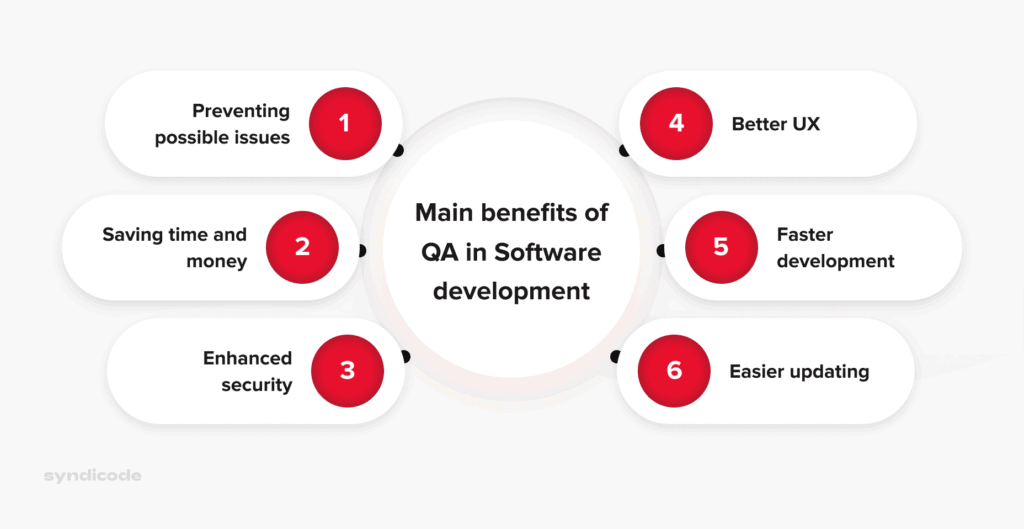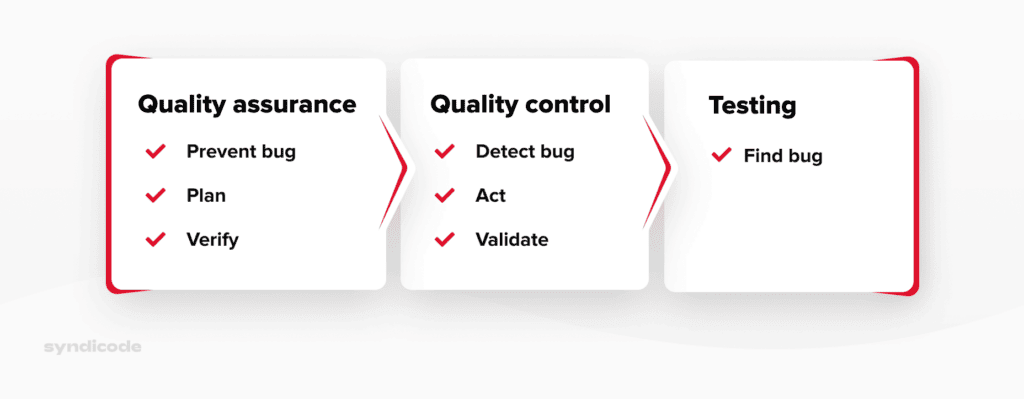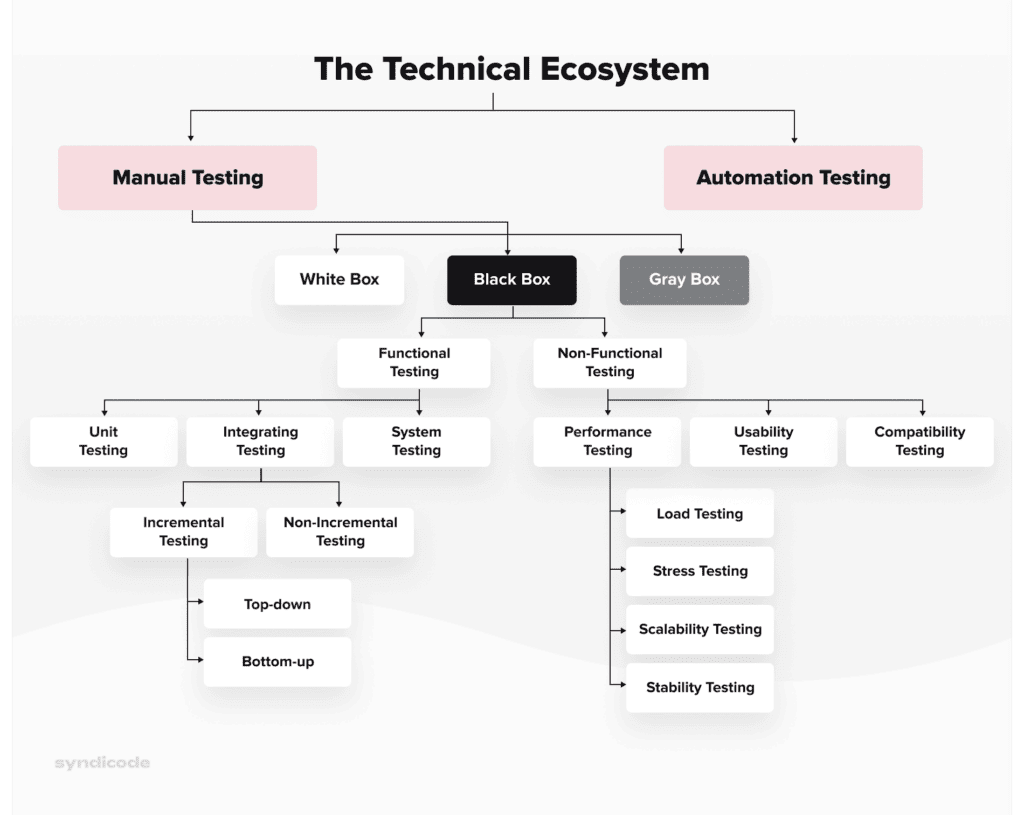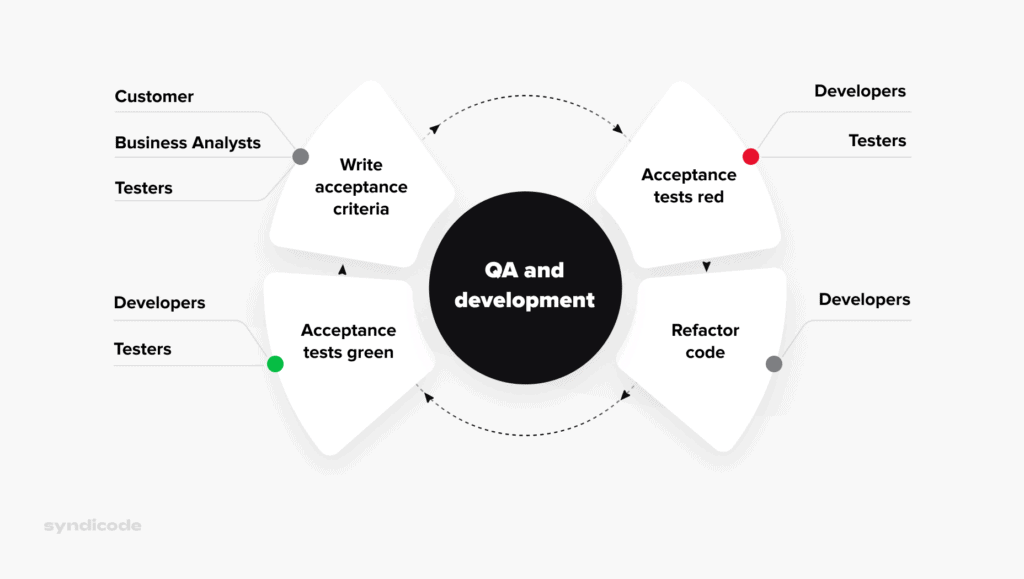Are you wondering why quality assurance is important? Then, you should recall when you had to hit “save” every couple of seconds because the software could glitch and erase all of your work.
Does it happen to your customers?
Then they will defect to your competitor before you can blink an eye and keep your tool a wide berth. The same will probably happen if your app takes ages to load or crashes with the rise of traffic. And you certainly don’t want it to leak your customers’ data.
But how can you ensure your digital product functions as intended under all circumstances?
The answer is—Quality Assurance.
Put simply, software quality assurance (QA) is a process that focuses on identifying the requirements for creating reliable, secure, and stable software and ensuring the end product meets those requirements.
Further in this post, you will learn about the importance of quality assurance in software development, the benefits of quality assurance, what testing is, its types, and classification. After reading, you will be able to evaluate the importance of software testing for your project and the effectiveness of the methods offered by your QA team.
For those in a hurry: the main reason why QA is important for your software development project is the guarantee that everything that happens throughout the development process is done effectively. And that the process is repeated without any deviation for all software parts.
What makes us an expert
At Syndicode, quality assurance and testing in software development are indispensable. Let’s take one of our ongoing projects, Evrlearn. We performed thorough requirements and functional testing of every feature upon its completion. This way, we ensured that everything we did in the project looked and worked as intended under all possible user scenarios.
Besides, we saw that all system modules worked well together through integration testing. In particular, API testing validated the logic of the built architecture in practice and that all the platform features were easy to access.
As a result, the website currently requires minimal technical support to keep up to date with the changing technologies and industry standards. We have a stable solution that provides excellent UX for users and scales easily according to business needs.

The role of QA and testing in software development
Putting quality first makes everyone in a business focus on defect-free results. In terms of development, software testing services involve implementing effective routines that foresee possible problems and prevent the need for workarounds.
Companies that realize the importance of quality assurance encourage employees to look at every part of the software development process as a “product” that has its “consumer”. Thus, a business analyst provides information to project managers, designers, and developers. A designer creates a product to be used by developers, who will turn visuals and wireframes into a working code, and so on.
Defects are possible at each stage, so it’s important to ensure all participants adhere to the quality standards.
What will happen if you neglect QA? Software bugs are known for causing millions of dollars of losses, such as Nissan’s airbag software issue or Starbucks’s service of coffee for free due to a mistake in its POS system.
But even if the worst thing a malfunction can do is disappoint a user, it still leads to major reputation losses. Equifax, an American credit reporting agency, is still recovering from the security breach caused by a bug in 2018 that caused a 28% share fall.

Objectives of QA
One of the major reasons why quality assurance is important is that it works towards the standardization of software development processes. A consistent result is impossible if a function operates differently depending on who does it and when. The solution to this problem is to clearly explain the desired outcome under a certain condition.
This way, a digital product is created with quality already “built-in”, rather than going through the product’s constituents and trying to bring them up to the desired level after the development is finished. The latter also happens if the quality assurance process is implemented at the very end of the software life cycle process.
Another QA objective is to limit variation where it’s unavoidable by outlining the limits of normal variation and those that represent a problem. Finally, and maybe most importantly, QA aims to deliver maximum value to the end-user. In some cases, everything that doesn’t bring any value should be removed.

The difference between QA and software testing
When discussing the importance of quality assurance, people often use “quality assurance” and “software testing” interchangeably. In fact, there is a difference.
QA is an effort to implement and improve digital quality throughout the software development lifecycle. What happens after a product has already been developed is called quality control (QC), a set of activities aimed to ensure the product meets the customer’s criteria. As a part of QC, there is testing, which is planning and executing tests to meet the goal of QC. But why do we need software testing if there is quality assurance?
The software testing definition can be formulated as follows. Software testing is finding errors in the developed product and matching the outcomes with the expected results. The main differences between testing and QA are:
- Quality assurance helps to identify and prevent possible issues before they appear. In contrast, software testing aims to detect defects and ensure they are fixed.
- QA is focused on end-user satisfaction, ensuring the product’s features and functions meet the client’s requirements. At the same time, software testing focuses on test cases and their implementation to properly search for defects.
- Software quality assurance has a lot to do with management, involving creating policies, training, selecting tools, and team building. Testing in software engineering, though, is a process of writing different tests to find different bugs.

When should you implement QA in your project?
While we strongly recommend introducing quality assurance as early as possible, sometimes the importance of quality assurance becomes diminished by a limited budget or other factors. If that’s the case, you can do it at any stage of the software development lifecycle. Often, testing starts only after the code is completed.
In this case, the main focus is on the functionality and each feature working properly. However, it’s impossible to do an all-inclusive check of code which may affect the system stability.
Also, when emphasizing functionality, it is easy to lose the full scope of why the feature was built. As a result, the software might not fully reflect the client’s intentions.
Starting QA at the discovery and design phases allows the QA team to understand better the product’s goal and the reasoning behind each feature. This way, they can come up with the most efficient way to implement and incorporate UX into testing. Eventually, the product has a higher chance of being satisfactory both in functionality and user experience.
Benefits of quality assurance
Regardless of when you decide to start QA in the software life cycle, it will improve the quality of your digital product. Quality assurance practices increase the relevance of software testing methods, aligning them with the overall development strategy. The following benefits add to the importance of quality assurance.
Resources saving
The major reason why quality assurance is important is that a bug found early can cost nothing to fix. But the same bug hidden within billions of code lines requires time to be identified and can delay delivery. The increase in time, in turn, increases costs logarithmically.
Moreover, if not found, a bug may cause tremendous harm after release, from a malfunction to system failure. In that case, you will have to call your product back for more thorough testing and rework, which means more expenses and reputation losses.
Enhanced security
Code quality and security are two sides of the same coin. Whereas a user sees a usability issue, a cyber attacker sees an opportunity they can use to stress the system. Therefore, the better the code quality, the more predictable its behavior and the fewer system vulnerabilities.
There is also a separate type of testing in software engineering aimed at validating a product’s security. Security testing focuses on detecting network weaknesses and can involve so-called ethical hacking to expose potential security flaws.
UX improvement
If the software is challenging to use, tends to crash, is unclear about the next step of the user journey, or there are just too many buttons, the customer will be unlikely to do business with you again. One of the benefits of quality assurance is minimizing the risk of having those issues.
For example, user-based testing determines how users interact with real concepts and identifies friction before they are built. And functional testing enhances back-end functions and detects problems with the front-end interface before the product goes into production.
Still not convinced about the importance of quality assurance?
Faster development
If software testers work in parallel with developers, they find defects and report them to be fixed as soon as the next unit of the system is completed. This allows developers to go back and fix everything quickly while the code is still fresh in their memory.
One more reason why quality assurance is important lies in the cooperation between development and testing teams and providing a plan of consistent fixes. This way, no one has to deal with constant errors and frantic communication.
Simpler features adding
The older the code and the more interconnected its parts, the harder it is to add new functionality without breaking anything. Testing in software engineering helps developers know about the crucial parts of the code and boosts their confidence. A new development team will know where to look if something goes wrong after building another feature and will appreciate your understanding of the importance of quality assurance.
Begin your journey toward excellence
Create a high-quality product with our expert team. Fill out the form to start!
Get in touchWhat should you know about software testing?
Now that you see why quality assurance is important, let’s talk about its subset. Software testing is classified by type, method, technique, and testing level. Thus, different types of testing in QA describe the intention of the performed testing: to check the system’s performance or the adherence of its parameters to a standard.
Methods differ by the amount of the tester’s interaction with the system. A certain software testing technique is used to assess different parts of the tested system. And testing levels describe what exactly was tested: the structure of the system part, its behavior, or interaction between several units.
The following software testing set is commonly used for an average software product.
Testing levels:
- Component testing
- Integration testing
- System testing
- Acceptance testing
At each level, the following testing types can be applied:
- Functional testing
- Non-functional testing
- Change-related testing
- Testing by knowledge of the system
Software testing methods:
- Static testing
- Dynamic testing
Testing techniques:
- Black-box testing
- White-box testing
- Experience-based testing
Now, let’s look at each level, type, method, and technique in more detail.

Types of testing in software engineering
Manual testing
Manual testing involves a human tester checking a new system’s functionality using no readymade tools. The benefits of testing software manually are indisputable. There is the need to check the convenience and user-friendliness of an interface, verify a system’s performance under different scenarios and user behaviors, and shape an overall opinion about an application.
The main disadvantage of manual testing is that it’s time-consuming. Hence, it’s impractical to use for load testing, regression tests, and where there is the need to find slight differences among multiple similar objects.
Automated testing
Automated tests are fast and can repeatedly run without losses in productivity or accuracy. Yet, because of the high cost of automation tools, this testing type makes sense to apply for large long-term projects requiring repetitive testing. Also, there are some areas that cannot be automated, such as UX or complex functionality.
Similarly, it’s not reasonable to perform automated testing when software is still under development since the tests will require frequent updates, which may take more time than a manual check.
Testing methods
Static testing
This testing method is applied early in the development process before there is any completed module to execute. It aims to ensure all the project documentation is available, clear, and implementable.
Static testing is also used for code inspection for syntax, adherence to standards, and optimization. This testing method can cut the probability of flaw emergence by 85%.
Dynamic testing
In dynamic testing, the code is executed to check software performance in a run-time environment. The testing ensures that an app’s behavior, CPU usage, and overall performance meet the expectations. It also identifies weak areas, yet static testing is necessary to trace vulnerabilities.
Testing techniques
White-box testing
White-box testing examines program structure and makes conclusions based on the system’s logic. A test case repeatedly runs a code with given input values and compares them with the output. If the values don’t match, then it is a bug.
This testing technique allows for checking individual code sections and how they link to others before any GUI is built. It is also very thorough. However, white-box testing won’t tell you if an expected functionality is absent from the code, and it is hard to do manually.
Black-box testing
Black-box testing is a functional testing technique that “doesn’t care” about the internal system processes. A tester simulates user activity and sees if the system returns the expected result. For example, using the black-box technique, one can verify whether it’s possible to log in using the right credentials and not possible to log in with the wrong credentials.
Black-box testing effectively validates the system’s response times, usability, and reliability under different user actions. However, this technique doesn’t expose security vulnerabilities or data flow issues.
Testing levels
Unit testing
Testing individual components of software helps developers learn what functionality is provided by an individual module of an existing system in a case when a new team takes on development. Further, since each module is tested in isolation, possible breaking points are detected easily. Also, unit testing helps to control the code complexity, contributing to clean and efficient choices.
On the cons side, unit testing is time-consuming, can’t be used for legacy code, and is not applicable for GUI.
Integration testing
The goal of integration testing is to ensure third-party integrations work with the internal system elements as they should. A module can work well in isolation but return errors while interacting with another module. Testing at this level is crucial when different developers or teams create the system parts to validate there wasn’t a mismatch in requirements understanding.
The primary disadvantage of integration testing is that it is time-consuming.
End-to-end testing
The goal of end-to-end testing is to test the entire application from start to finish from the end-user’s perspective. To check the app’s behavior and the integrity of its components, a tester imitates a real user scenario. The testing increases confidence in the product for release and minimizes the risk of failure.
Unfortunately, in case of E2E testing failure, unit or integration testing is needed to find the root of the issue. Also, it might be difficult to fully re-create the environment for a real-world scenario.
Acceptance testing
Acceptance tests ensure the application provides valuable functionality to end-users. Typically, this is the final step of software testing, and a focus group of real customers is invited to perform the tests. A product that passes acceptance testing can be considered adequate and market-ready.
On the other hand, it is often difficult to write tests that are not overly technical for the customers. And since testers are only looking for defects they expect to find, some underlying issues may be missed.

Syndicode’s approach to software testing
Being a full-cycle custom software development company, we stress the importance of quality assurance and strive to introduce QA as early as possible in the software life cycle. This way, we minimize the need for rework and cut the associated costs for development.
Thus, starting at the project requirements gathering stage, our QA engineers analyze the functional and non-functional software requirements for clarity, completeness, traceability, and testability.
Based on the gathered requirements, we create a test plan. It contains a test strategy, scope, budget, and deadlines and describes the necessary types and levels of tests, procedures, and resources.
Next, we design test checklists. A checklist outlines lists of items to be tested and the passing criteria. Then we plan and set a test environment that closely mimics the production environment in terms of hardware, software, network configurations, operating system settings, databases, and others.
Test execution starts with unit testing performed by the development team. A developer completes a system unit and checks if it functions properly right away. The testing team takes over UI and API testing. After a defect is found and fixed, we run regression tests to ensure the change doesn’t affect the related functionality.
Once the product is ready for release, the test team determines the test suites necessary to cover the scope of the deployed build. We check the system for stability, and if all the tests are passed successfully, we issue a test report.
The procedure has been time-tested and proven efficient for our projects. Client reviews confirm that software developed by the Syndicode team works perfectly for their business goals. Our solutions provide reliable assistance in solving problems and are effective growth boosters.
So, why is quality assurance important?
Software quality assurance stimulates your team to analyze errors and improve them before the product reaches customers and hurts their satisfaction and loyalty. The quality assurance process aims to guarantee that a software product will work per the expectations without any problems.
Assembling a QA team requires investment in searching for the relevant expertise and purchasing equipment. While this is justified for long projects, you can outsource QA from a trusted web development partner for short or one-time development. Why is quality important for a business? Without it, you risk getting a product that behaves unexpectedly should something deviate in its environment. A sloppily made product is hard to update, and there is a high chance that should you want to add or remove something, you’ll have to rebuild the entire system from scratch.
Frequently asked questions
-
Why is quality control important?
Quality control is a component of the overall QA process that focuses on ensuring that the products meet quality standards before reaching the customer. The advantages of implementing quality control include preventing defective products from being delivered to customers and enhancing oversight of the work performed by employees.
-
How much does quality assurance cost?
Understanding why quality assurance is important naturally leads to questions about its cost. It varies based on several factors including the QA specialist’s qualifications, project complexity, market conditions, and deadlines. In general, the longer the project duration and the earlier QA is introduced into the development process, the higher the associated costs, potentially accounting for up to 30% of total development expenses. However, incorporating QA early on can significantly reduce the risk of costly product recalls due to quality issues. Something to weigh thoughtfully. Team size also affects costs; larger QA teams mean higher total salaries. In the United States, salary data from Glassdoor indicates that an average QA team lead earns around $47 per hour, a QA engineer’s salary ranges from $40 to $50/hour, and a QA tester makes between $37 and $45 per hour. Thus, projects requiring a higher proportion of senior-level employers for testing will incur greater costs. However, outsourcing QA to regions like Europe can offer substantial savings, reducing QA expenses by at least half compared to domestic costs.
-
How can an entrepreneur choose a good company for quality assurance services?
Selecting the right QA partner in a crowded marketplace can be challenging. Yet, certain indicators can help you identify a provider with genuine expertise and proficiency in modern technology. First of all, an experienced QA company will have a broad range of case studies showcasing their work. Review these to ensure they offer the specific services you need. Look for feedback that highlights the company’s ability to deliver value and align with client expectations. Reviews should also reflect their flexibility in adapting to various testing environments and evolving technologies. Upon contacting a QA company, note if they express genuine interest in your project by asking detailed questions about product expectations, intended value for end-users, and your target audience. A committed QA vendor aims to gather as much information as possible to improve their services. Next, examine the company’s pricing structure and compare it with the industry average. While cost-efficiency is important, remember that the cheapest option may not provide the best value, and the most expensive one isn’t automatically the highest quality. Finally, pay attention to how you feel during interactions with the potential vendor. You should feel understood and find their explanations clear and logical. Considering you’ll be in regular communication about work-related matters, a comfortable and open dialogue is crucial for a successful partnership.
-
Is it safe to outsource the quality control of my product?
Outsourcing QA can be a strategic move for business owners who recognize the importance of quality assurance but lack the resources to carry it out internally. You can mitigate potential security risks by doing thorough background checks on prospective outsourcing partners and creating detailed contracts with clauses for confidentiality and data protection. Moreover, it’s important to set clear quality standards with your QA service provider before beginning collaboration and to establish secure and efficient communication channels. Consider appointing a dedicated project manager to monitor the outsourcing relationship and help ensure adherence to these standards. Additionally, sit down with your partner to create a risk management plan. If you still have concerns, initiating a pilot project can be an effective way to evaluate the effectiveness of the collaboration.
